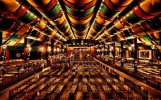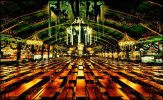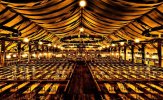Tui
Jedi
In my city, posters have been up for a couple of weeks reminding everyone about the local Oktoberfest starting tomorrow (Friday) afternoon and lasting until Saturday night - luckily it doesn't last for two plus weeks as does this biggest Volksfest in the world which is held annually in Munich, Germany, when about 6 million people visit the Theresienwiese (42 hectares) every year, swilling about 7.7 million litres of beer and enjoying the parades, singing and the funfair. Nevertheless, the beer god is also worshiped here in big tents with a funfair going for the children. (However, the carefree fun could be more sober this year as the main topics of discussion in the big beer tents in Munich might be the depressing migrant crisis in Europe and all the ongoing and looming wars everywhere on the planet.)
A brief history of this fest, according to Wikipedia: Crown Prince Ludwig, later to become King Ludwig I, was married to Princess Therese of Saxe-Hildburghausen on October 12, 1810. The citizens of Munich were invited to attend the festivities held on the fields in front of the city gates to celebrate the happy royal event. The fields were named Theresienwiese ("Theresa's meadow") in honor of the Crown Princess, and have kept that name ever since, although the locals have since abbreviated the name simply to "Wiesn". Horse races and a parade took place for the first time during this celebration. Since 1850, the parade has become an annual event and an important component of the Oktoberfest. Eight thousand people — mostly from Bavaria — and dressed in traditional costumes walk from Maximilian Street through the centre of Munich to the Oktoberfest grounds. In 1880, electric light illuminated more than 400 booths and tents. In 1881, booths selling bratwurst opened and the first beer was served in glass mugs in 1892. At the end of the 19th century, a re-organization took place. Until then, there were games of skittles, large dance floors, and trees for climbing in the beer booths. Organizers wanted more room for guests and musicians which resulted in the booths becoming beer halls which are still used today. Since 1950, there has been a traditional festival opening: A twelve gun salute and the tapping of the first keg of Oktoberfest beer at 12:00 by the incumbent Mayor of Munich with the cry "O'zapft is!" ("It's tapped!" in the Austro-Bavarian dialect) opens the Oktoberfest. By 1960, the Oktoberfest had become a world-famous festival. On the occasion of the 200th anniversary in 2010 a so-called Historisches Oktoberfest (Historical Oktoberfest) was [held]; the six Munich breweries Augustiner, Hacker-Pschorr, Hofbräu, Löwenbräu, Paulaner and Spaten presented a special exclusively brewed dark beer, which was made after a historic recipe from the early 19th century. Only beer conforming to the Reinheitsgebot, and brewed within the city limits of Munich, can be served at the Munich Oktoberfest. Beers meeting these criteria are designated Oktoberfest Beer. Veteran bartenders take a mere 1.5 seconds to fill up a litre stein.
Der Spiegel online has published some of photographer Michael von Hassels' impressive images of these enormous tent "cathedrals" erected in honour of the beer god. Von Hassels "Cathedrals" are on show at Munich's Rathausgalerie Kunsthalle (prints sell for Euro15000 each!) until 10 October. He takes these photographs in the quiet early morning hours after the cleaners have tidied up the tents. "I wanted to find out what it's really all about," the artist says. "What I encountered was tradition, ritual, singing, customs, masses of people, giant buildings." All things he associated with cathedrals. "People also come to the tents to worship," he says. "What they worship here is beer and filthy lucre."
See more of his "Cathedral" images at http://www.spiegel.de/international/zeitgeist/michael-von-hassel-takes-photos-of-empty-oktoberfest-tents-a-1053087.html
A brief history of this fest, according to Wikipedia: Crown Prince Ludwig, later to become King Ludwig I, was married to Princess Therese of Saxe-Hildburghausen on October 12, 1810. The citizens of Munich were invited to attend the festivities held on the fields in front of the city gates to celebrate the happy royal event. The fields were named Theresienwiese ("Theresa's meadow") in honor of the Crown Princess, and have kept that name ever since, although the locals have since abbreviated the name simply to "Wiesn". Horse races and a parade took place for the first time during this celebration. Since 1850, the parade has become an annual event and an important component of the Oktoberfest. Eight thousand people — mostly from Bavaria — and dressed in traditional costumes walk from Maximilian Street through the centre of Munich to the Oktoberfest grounds. In 1880, electric light illuminated more than 400 booths and tents. In 1881, booths selling bratwurst opened and the first beer was served in glass mugs in 1892. At the end of the 19th century, a re-organization took place. Until then, there were games of skittles, large dance floors, and trees for climbing in the beer booths. Organizers wanted more room for guests and musicians which resulted in the booths becoming beer halls which are still used today. Since 1950, there has been a traditional festival opening: A twelve gun salute and the tapping of the first keg of Oktoberfest beer at 12:00 by the incumbent Mayor of Munich with the cry "O'zapft is!" ("It's tapped!" in the Austro-Bavarian dialect) opens the Oktoberfest. By 1960, the Oktoberfest had become a world-famous festival. On the occasion of the 200th anniversary in 2010 a so-called Historisches Oktoberfest (Historical Oktoberfest) was [held]; the six Munich breweries Augustiner, Hacker-Pschorr, Hofbräu, Löwenbräu, Paulaner and Spaten presented a special exclusively brewed dark beer, which was made after a historic recipe from the early 19th century. Only beer conforming to the Reinheitsgebot, and brewed within the city limits of Munich, can be served at the Munich Oktoberfest. Beers meeting these criteria are designated Oktoberfest Beer. Veteran bartenders take a mere 1.5 seconds to fill up a litre stein.
Der Spiegel online has published some of photographer Michael von Hassels' impressive images of these enormous tent "cathedrals" erected in honour of the beer god. Von Hassels "Cathedrals" are on show at Munich's Rathausgalerie Kunsthalle (prints sell for Euro15000 each!) until 10 October. He takes these photographs in the quiet early morning hours after the cleaners have tidied up the tents. "I wanted to find out what it's really all about," the artist says. "What I encountered was tradition, ritual, singing, customs, masses of people, giant buildings." All things he associated with cathedrals. "People also come to the tents to worship," he says. "What they worship here is beer and filthy lucre."
See more of his "Cathedral" images at http://www.spiegel.de/international/zeitgeist/michael-von-hassel-takes-photos-of-empty-oktoberfest-tents-a-1053087.html




